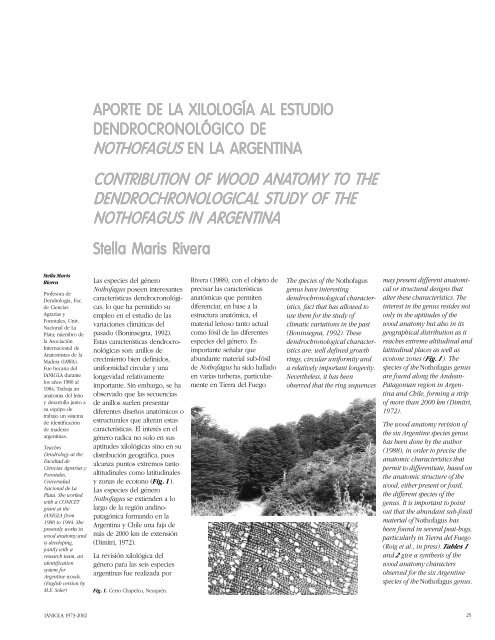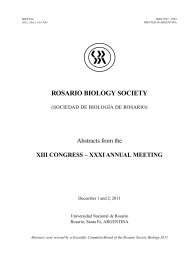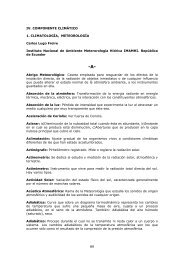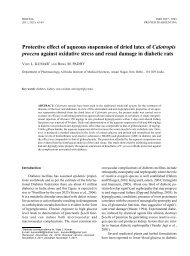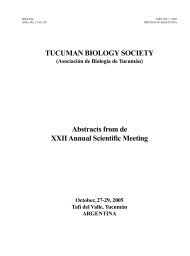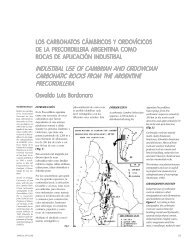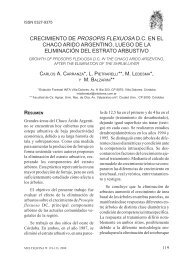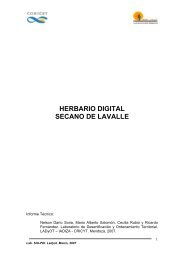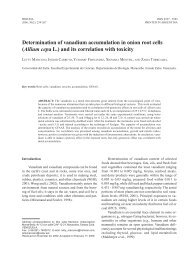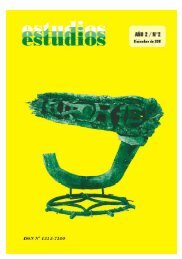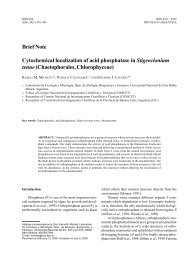Aporte de la Xilología al estudio dendrocronológico de nothofagus ...
Aporte de la Xilología al estudio dendrocronológico de nothofagus ...
Aporte de la Xilología al estudio dendrocronológico de nothofagus ...
Create successful ePaper yourself
Turn your PDF publications into a flip-book with our unique Google optimized e-Paper software.
Stel<strong>la</strong> Maris<br />
Rivera<br />
Profesora <strong>de</strong><br />
Dendrología, Fac.<br />
<strong>de</strong> Ciencias<br />
Agrarias y<br />
Forest<strong>al</strong>es, Univ.<br />
Nacion<strong>al</strong> <strong>de</strong> La<br />
P<strong>la</strong>ta; miembro <strong>de</strong><br />
<strong>la</strong> Asociación<br />
Internacion<strong>al</strong> <strong>de</strong><br />
Anatomistas <strong>de</strong> <strong>la</strong><br />
Ma<strong>de</strong>ra (IAWA).<br />
Fue becaria <strong>de</strong>l<br />
IANIGLA durante<br />
los años 1980 <strong>al</strong><br />
1984. Trabaja an<br />
anatomía <strong>de</strong>l leño<br />
y <strong>de</strong>sarrol<strong>la</strong> junto a<br />
su equipo <strong>de</strong><br />
trabajo un sistema<br />
<strong>de</strong> i<strong>de</strong>ntificación<br />
<strong>de</strong> ma<strong>de</strong>ras<br />
argentinas.<br />
Teaches<br />
Dendrology at the<br />
Facultad <strong>de</strong><br />
Ciencias Agrarias y<br />
Forest<strong>al</strong>es,<br />
Universidad<br />
Nacion<strong>al</strong> <strong>de</strong> La<br />
P<strong>la</strong>ta. She worked<br />
with a CONICET<br />
grant at the<br />
IANIGLA from<br />
1980 to 1984. She<br />
presently works in<br />
wood anatomy and<br />
is <strong>de</strong>veloping,<br />
jointly with a<br />
research team, an<br />
i<strong>de</strong>ntification<br />
system for<br />
Argentine woods.<br />
(English version by<br />
M.E. Soler)<br />
APORTE APORTE DE DE LA LA XILOLOGÍA XILOLOGÍA AL AL ESTUDIO<br />
ESTUDIO<br />
DENDROCRONOLÓGICO DENDROCRONOLÓGICO DE<br />
DE<br />
NOTHOF NOTHOFAGUS<br />
NOTHOF AGUS EN EN LA LA ARGENTINA<br />
ARGENTINA<br />
CONTRIBUTION CONTRIBUTION OF OF WOOD WOOD ANA ANATOMY ANA TOMY TO TO THE<br />
THE<br />
DENDROCHRONOLOGICAL DENDROCHRONOLOGICAL STUDY STUDY OF OF THE<br />
THE<br />
NOTHOF NOTHOFAGUS NOTHOF AGUS IN IN ARGENTINA<br />
ARGENTINA<br />
Stel<strong>la</strong> Stel<strong>la</strong> Maris Maris Rivera<br />
Rivera<br />
Las especies <strong>de</strong>l género<br />
Nothofagus poseen interesantes<br />
características <strong>de</strong>ndrocronológicas,<br />
lo que ha permitido su<br />
empleo en el <strong>estudio</strong> <strong>de</strong> <strong>la</strong>s<br />
variaciones climáticas <strong>de</strong>l<br />
pasado (Boninsegna, 1992).<br />
Estas características <strong>de</strong>ndrocronológicas<br />
son: anillos <strong>de</strong><br />
crecimiento bien <strong>de</strong>finidos,<br />
uniformidad circu<strong>la</strong>r y una<br />
longevidad re<strong>la</strong>tivamente<br />
importante. Sin embargo, se ha<br />
observado que <strong>la</strong>s secuencias<br />
<strong>de</strong> anillos suelen presentar<br />
diferentes diseños anatómicos o<br />
estructur<strong>al</strong>es que <strong>al</strong>teran estas<br />
características. El interés en el<br />
género radica no solo en sus<br />
aptitu<strong>de</strong>s xilológicas sino en su<br />
distribución geográfica, pues<br />
<strong>al</strong>canza puntos extremos tanto<br />
<strong>al</strong>titudin<strong>al</strong>es como <strong>la</strong>titudin<strong>al</strong>es<br />
y zonas <strong>de</strong> ecotono (Fig. 1).<br />
Las especies <strong>de</strong>l género<br />
Nothofagus se extien<strong>de</strong>n a lo<br />
<strong>la</strong>rgo <strong>de</strong> <strong>la</strong> región andinopatagónica<br />
formando en <strong>la</strong><br />
Argentina y Chile una faja <strong>de</strong><br />
más <strong>de</strong> 2000 km <strong>de</strong> extensión<br />
(Dimitri, 1972).<br />
La revisión xilológica <strong>de</strong>l<br />
género para <strong>la</strong>s seis especies<br />
argentinas fue re<strong>al</strong>izada por<br />
Fig. 1. Cerro Chapelco, Neuquén.<br />
Rivera (1988), con el objeto <strong>de</strong><br />
precisar <strong>la</strong>s características<br />
anatómicas que permiten<br />
diferenciar, en base a <strong>la</strong><br />
estructura anatómica, el<br />
materi<strong>al</strong> leñoso tanto actu<strong>al</strong><br />
como fósil <strong>de</strong> <strong>la</strong>s diferentes<br />
especies <strong>de</strong>l género. Es<br />
importante seña<strong>la</strong>r que<br />
abundante materi<strong>al</strong> sub-fósil<br />
<strong>de</strong> Nothofagus ha sido h<strong>al</strong><strong>la</strong>do<br />
en varias turberas, particu<strong>la</strong>rmente<br />
en Tierra <strong>de</strong>l Fuego<br />
The species of the Nothofagus<br />
genus have interesting<br />
<strong>de</strong>ndrochronologic<strong>al</strong> characteristics,<br />
fact that has <strong>al</strong>lowed to<br />
use them for the study of<br />
climatic variations in the past<br />
(Boninsegna, 1992). These<br />
<strong>de</strong>ndrochronologic<strong>al</strong> characteristics<br />
are: well <strong>de</strong>fined growth<br />
rings, circu<strong>la</strong>r uniformity and<br />
a re<strong>la</strong>tively important longevity.<br />
Nevertheless, it has been<br />
observed that the ring sequences<br />
may present different anatomic<strong>al</strong><br />
or structur<strong>al</strong> <strong>de</strong>signs that<br />
<strong>al</strong>ter these characteristics. The<br />
interest in the genus resi<strong>de</strong>s not<br />
only in the aptitu<strong>de</strong>s of the<br />
wood anatomy but <strong>al</strong>so in its<br />
geographic<strong>al</strong> distribution as it<br />
reaches extreme <strong>al</strong>titudin<strong>al</strong> and<br />
<strong>la</strong>titudin<strong>al</strong> p<strong>la</strong>ces as well as<br />
ecotone zones (Fig. 1). The<br />
species of the Nothofagus genus<br />
are found <strong>al</strong>ong the An<strong>de</strong>an-<br />
Patagonian region in Argentina<br />
and Chile, forming a strip<br />
of more than 2000 km (Dimitri,<br />
1972).<br />
The wood anatomy revision of<br />
the six Argentine species genus<br />
has been done by the author<br />
(1988), in or<strong>de</strong>r to precise the<br />
anatomic characteristics that<br />
permit to differentiate, based on<br />
the anatomic structure of the<br />
wood, either present or fossil,<br />
the different species of the<br />
genus. It is important to point<br />
out that the abundant sub-fossil<br />
materi<strong>al</strong> of Nothofagus has<br />
been found in sever<strong>al</strong> peat-bogs,<br />
particu<strong>la</strong>rly in Tierra <strong>de</strong>l Fuego<br />
(Roig et <strong>al</strong>., in press). Tables 1<br />
and 2 give a synthesis of the<br />
wood anatomy characters<br />
observed for the six Argentine<br />
species of the Nothofagus genus.<br />
IANIGLA 1973-2002 25
Tab<strong>la</strong> 1 / Table 1<br />
26<br />
N. obliqua N. <strong>al</strong>pina N. pumilio N. antarctica N. dombeyi N. betuloi<strong>de</strong>s<br />
Elemento <strong>de</strong> vaso<br />
Vessel element<br />
Long. (um) max. 730 800 700 600 850 750<br />
min. 500 420 450 500 500 450<br />
Æ tg. (um) 60 90 50 40 70 70<br />
Densidad (Nº/mm2 )<br />
Density<br />
Fibras<br />
Fibres<br />
60 120 450 250 80 110<br />
Long. (um) max. 1000 1600 700 1000 1100 1000<br />
min. 900 1000 500 900 700 800<br />
Radios<br />
Rays<br />
uniseriados (%) 25 30 80 70 95 90<br />
uniseriate<br />
biseriados (%) 70 70 20 30 5 10<br />
biseriate<br />
triseriados (%) 5<br />
triseriate<br />
<strong>al</strong>tura (Nº <strong>de</strong> cel.) max. 20 25 40 24 20 22<br />
heigth (Nº of cells)<br />
min. 7 6 2 5 6<br />
x 12 16 15 13 13 11<br />
cantidad (Nº/mm) 6-10 8-15 18-20 6-12 13-15 8-15<br />
quantity<br />
Tab<strong>la</strong> 2 / Table 2<br />
N. obliqua N. <strong>al</strong>pina N. pumilio N. antarctica N. dombeyi N. betuloi<strong>de</strong>s<br />
Porosidad<br />
Porosity<br />
difusa + + + + + +<br />
diffuse<br />
semicircu<strong>la</strong>r + +<br />
semicircu<strong>la</strong>r<br />
Distribución<br />
Distribution<br />
solitarios + + + + + +<br />
single<br />
mult. rad. + + + + + +<br />
mult. rays<br />
en racimos + + + + + +<br />
in clusters<br />
P<strong>la</strong>ca <strong>de</strong> perforación<br />
Perforation p<strong>la</strong>te<br />
simple + + + + + +<br />
simple<br />
esca<strong>la</strong>riforme +<br />
sca<strong>la</strong>riform<br />
Tíli<strong>de</strong>s + + + + + +<br />
Tylosis<br />
Refuerzo S 3<br />
Thickening S 3<br />
espira<strong>la</strong>do + + +<br />
helic<strong>al</strong><br />
reticu<strong>la</strong>do +<br />
reticu<strong>la</strong>te<br />
Parénquima axi<strong>al</strong><br />
Axi<strong>al</strong> parenchyma<br />
apotraque<strong>al</strong> escaso + +<br />
scarce apotrache<strong>al</strong><br />
paratraque<strong>al</strong> escaso +<br />
scarce paratrache<strong>al</strong><br />
ausente + + + +<br />
absent<br />
Radios heterogéneos + + + + + +<br />
Heterogeneous rays<br />
Contenidos tánicos + + + +<br />
Tanine<br />
(Roig et <strong>al</strong>., en prensa). Se<br />
sintetizan en <strong>la</strong>s Tab<strong>la</strong>s 1 y 2<br />
los caracteres xilológicos<br />
observados para <strong>la</strong>s seis<br />
especies argentinas <strong>de</strong>l género<br />
Nothofagus.<br />
Las divergencias cuantitativas<br />
<strong>de</strong> <strong>la</strong> Tab<strong>la</strong> 1 no son suficientes<br />
como para permitir <strong>la</strong><br />
separación <strong>de</strong> especies<br />
basándose en el<strong>la</strong>s. Se<br />
propone una c<strong>la</strong>ve.<br />
Dadswell e Ingle (1954),<br />
basándose en caracteres<br />
xilológicos, separan dos<br />
grupos <strong>de</strong> Nothofagus, los <strong>de</strong><br />
Nueva Guinea y los <strong>de</strong><br />
Sudamérica, Nueva Ze<strong>la</strong>nda y<br />
<strong>al</strong> este <strong>de</strong> Austr<strong>al</strong>ia. En <strong>la</strong><br />
Tab<strong>la</strong> 3 se comparan los datos<br />
xilológicos obtenidos por<br />
distintos autores para esas<br />
regiones con los <strong>de</strong>l nuevo<br />
<strong>estudio</strong>. De <strong>la</strong> comparación se<br />
<strong>de</strong>spren<strong>de</strong> que existe entre <strong>la</strong>s<br />
especies una intergradación <strong>de</strong><br />
los caracteres y que <strong>la</strong>s<br />
diferencias entre <strong>la</strong>s mismas<br />
son sutiles, necesitándose <strong>de</strong><br />
otras evi<strong>de</strong>ncias botánicas para<br />
separar<strong>la</strong>s.<br />
La datación <strong>de</strong>l materi<strong>al</strong> leñoso<br />
<strong>de</strong> Nothofagus resulta en<br />
ciertos casos problemática.<br />
Con el fin <strong>de</strong> <strong>al</strong><strong>la</strong>nar estas<br />
dificulta<strong>de</strong>s en el fechado, se<br />
re<strong>al</strong>izaron observaciones<br />
macro y microscópicas en<br />
secciones y macerados <strong>de</strong><br />
aquellos sectores <strong>de</strong> anillos<br />
con problemas <strong>de</strong> datación<br />
(Figs. 2 y 3). Este análisis se<br />
re<strong>al</strong>izó para una sección<br />
transvers<strong>al</strong> <strong>de</strong> Nothofagus<br />
pumilio “lenga” proveniente <strong>de</strong><br />
<strong>la</strong> Comarca Moquehue,<br />
Aluminé, Neuquén (aprox. 39°<br />
L.S., 71° L.O., 1000 m s.n.m.).<br />
La sección transvers<strong>al</strong> fue<br />
datada sobre seis radios. Las<br />
lecturas arrojaron un v<strong>al</strong>or<br />
medio <strong>de</strong> 271 años con v<strong>al</strong>ores<br />
extremos entre 278 y 266 años.<br />
Sobre los diferentes radios se<br />
<strong>de</strong>tectó <strong>la</strong> presencia <strong>de</strong>: a)<br />
anillos que aparecen en un<br />
sector <strong>de</strong>terminado y luego<br />
<strong>de</strong>saparecen fusionándose con<br />
The quantitative divergences of<br />
Table 1 are not enough to<br />
<strong>al</strong>low the separation of the<br />
species based on those<br />
differences. Is proposed a key.<br />
Dadswell and Ingle (1954)<br />
based on wood anatomy<br />
characters separate two<br />
Nothofagus groups, those from<br />
New Guinea and those from<br />
South America, New Zea<strong>la</strong>nd<br />
and west of Austr<strong>al</strong>ia. In Table<br />
3 there is a comparison of<br />
wood anatomy characters<br />
obtained by different authors<br />
for those regions with data<br />
obtained from the present<br />
study. From the comparison it<br />
is inferred that there exists<br />
between the species an<br />
intergradation of characters,<br />
and, that differences between<br />
species are subtle, therefore<br />
there is the need for other<br />
botanic<strong>al</strong> differences to<br />
separate them.<br />
Dating of the Nothofagus wood<br />
results problematic in certain<br />
cases. With the object of<br />
clearing this difficulties, macro<br />
and micro-observations were<br />
done in sections and macerates<br />
of those ring sectors with dating<br />
problems (Figs. 2 and 3). This<br />
an<strong>al</strong>ysis was done for a cross<br />
section of Nothofagus pumilio<br />
“lenga”, that came from<br />
Comarca Moquehue, Aluminé,<br />
Neuquén (aprox. 39° SL 71°<br />
WL, 1000 m a.s.l.). The crosssection<br />
was dated over six<br />
radios. Readings gave a mean<br />
v<strong>al</strong>ue of 271 years with extreme<br />
v<strong>al</strong>ues between 278 and 266<br />
years. Over the different radios<br />
it was <strong>de</strong>tected the presence of:<br />
a) rings that appear in a<br />
<strong>de</strong>termined sector and then<br />
disappear merging with the<br />
ring of the next year (wedging<br />
rings), b) in<strong>de</strong>nted rings close<br />
to the bark where it is difficult<br />
to <strong>de</strong>termine the growth rings,<br />
and c) sectors with very narrow<br />
rings (micro-rings) close to the<br />
pith.<br />
Following the microscopic<br />
an<strong>al</strong>ysis of the different sectors<br />
Dendrocronología - Dendrochronology
C<strong>la</strong>ve<br />
Key<br />
el anillo <strong>de</strong>l año siguiente<br />
(lentes <strong>de</strong> crecimiento); b)<br />
sectores <strong>de</strong> recorrido ondu<strong>la</strong>do<br />
próximos a <strong>la</strong> corteza don<strong>de</strong><br />
los anillos <strong>de</strong> crecimiento son<br />
<strong>de</strong> difícil <strong>de</strong>terminación, y c)<br />
sectores con anillos muy<br />
<strong>de</strong>lgados (microanillos)<br />
próximos a <strong>la</strong> médu<strong>la</strong>.<br />
Después <strong>de</strong> re<strong>al</strong>izar el análisis<br />
microscópico <strong>de</strong> los diferentes<br />
sectores con aparentes<br />
anom<strong>al</strong>ías anatómicas se<br />
concluyó que si bien hay<br />
variaciones en el diseño <strong>de</strong> los<br />
anillos <strong>de</strong> crecimiento, los<br />
datos cuantitativos (longitud <strong>de</strong><br />
vaso, longitud <strong>de</strong> fibras,<br />
tamaño <strong>de</strong> célu<strong>la</strong>s radi<strong>al</strong>es) no<br />
son significativamente<br />
diferentes. Se consi<strong>de</strong>ró que<br />
los elementos anatómicos <strong>de</strong><br />
conducción, <strong>al</strong>macenamiento y<br />
sostén conservan <strong>la</strong>s mismas<br />
características anatómicas en<br />
los diferentes sectores<br />
an<strong>al</strong>izados. Para encontrar<br />
parámetros anatómicos que<br />
presenten variaciones<br />
macroscópicas a lo <strong>la</strong>rgo <strong>de</strong><br />
una sección transvers<strong>al</strong>, se<br />
an<strong>al</strong>izaron también <strong>la</strong>s áreas<br />
ocupadas por los vasos (Rivera,<br />
1987).<br />
A partir <strong>de</strong>l análisis <strong>de</strong><br />
secciones transvers<strong>al</strong>es <strong>de</strong><br />
Nothofagus pumilio, <strong>de</strong> <strong>la</strong> zona<br />
<strong>de</strong>l Cerro Chapelco (aprox.<br />
40°L.S., 71° L.O.), Lácar,<br />
Neuquén, se pue<strong>de</strong> concluir<br />
que:<br />
a) El porcentaje <strong>de</strong>l área <strong>de</strong><br />
vasos en re<strong>la</strong>ción <strong>al</strong> ancho tot<strong>al</strong><br />
<strong>de</strong>l anillo es casi constante, por<br />
lo tanto anillos <strong>de</strong>lgados tienen<br />
menor área bas<strong>al</strong> que anillos<br />
anchos, pero <strong>la</strong> proporción <strong>de</strong><br />
área <strong>de</strong> vasos en re<strong>la</strong>ción <strong>al</strong><br />
ancho tot<strong>al</strong> es simi<strong>la</strong>r; esto<br />
implica que no habría<br />
diferencia significativa si una<br />
cronología se <strong>de</strong>sarrol<strong>la</strong>ra<br />
utilizando el ancho <strong>de</strong>l anillo o<br />
el área <strong>de</strong> vasos.<br />
b) El pasaje <strong>de</strong>l leño temprano<br />
<strong>al</strong> tardío es gradu<strong>al</strong> y poco<br />
<strong>de</strong>marcado.<br />
A-Radios en su mayoría uniseriados; tipo Heterogéneo III.<br />
Rays, mostly uniseriate; Heterogeneous III<br />
B-Elementos <strong>de</strong> vaso con refuerzo <strong>de</strong> <strong>la</strong> capa S3 espira<strong>la</strong>do.<br />
Parénquima radi<strong>al</strong> sin contenidos tánicos.<br />
Vessel elements with prominent helic<strong>al</strong> thickenings in the S3<br />
<strong>la</strong>yer. Radi<strong>al</strong> parenchyma without tannic contents.<br />
C-Puntuaciones intervascu<strong>la</strong>res predominantemente<br />
opuestas. Porosidad difusa y semicircu<strong>la</strong>r.<br />
Intervascu<strong>la</strong>r pitting predominantly opposite. Wood<br />
diffuse-porous to semi-ring porous. N. betuloi<strong>de</strong>s<br />
CC-Puntuaciones intervascu<strong>la</strong>res predominantemente <strong>al</strong>ternas.<br />
Porosidad difusa.<br />
Intervascu<strong>la</strong>r pitting, predominantly <strong>al</strong>ternate. Wood<br />
diffuse-porous N. pumilio<br />
BB-Elemento <strong>de</strong> vaso con refuerzo <strong>de</strong> <strong>la</strong> capa S3 no<br />
espira<strong>la</strong>do. Parénquima radi<strong>al</strong> con contenidos tánicos.<br />
Vessel element with reticu<strong>la</strong>te thickenings. Radi<strong>al</strong><br />
parenchyma with tannic contents<br />
D-Elementos <strong>de</strong> vaso con refuerzo <strong>de</strong> <strong>la</strong> capa S3<br />
reticu<strong>la</strong>do, tabique marcadamente oblicuo y p<strong>la</strong>ca <strong>de</strong><br />
perforación or<strong>la</strong>da y subtermin<strong>al</strong>.<br />
Vessel elements with reticu<strong>la</strong>te thickenings, markedly<br />
oblique partition and perforation p<strong>la</strong>tes without<br />
perforation rim and <strong>al</strong>most termin<strong>al</strong>. N. dombeyi<br />
DD-Elementos <strong>de</strong> vaso sin refuerzo <strong>de</strong> <strong>la</strong> capa S3, tabique<br />
oblicuo y p<strong>la</strong>ca <strong>de</strong> perforación no or<strong>la</strong>da y termin<strong>al</strong>.<br />
Vessel elements without thickenings in the S3 <strong>la</strong>yer,<br />
oblique partition and perforation p<strong>la</strong>tes without<br />
perforation rim and termin<strong>al</strong>. N. antarctica<br />
AA-Radios predominantemente biseriados; tipo Heterogéneo IIB.<br />
Rays mostly biseriate; Heterogeneous IIB.<br />
E-Parénquima axi<strong>al</strong> crist<strong>al</strong>ífero. Porosidad difusa.<br />
Crist<strong>al</strong>liferous axi<strong>al</strong> parenchyma. Wood diffuseporous.<br />
N. obliqua<br />
EE-Parénquima axi<strong>al</strong> ausente. Porosidad difusa y<br />
semicircu<strong>la</strong>r.<br />
Absent axi<strong>al</strong> parenchyma. Wood diffuse to semidiffuse<br />
porous. N. <strong>al</strong>pina<br />
c) La disminución en el<br />
diámetro medio <strong>de</strong> los vasos<br />
<strong>de</strong>l leño temprano <strong>al</strong> leño<br />
tardío es mínima.<br />
d) Las fibras y <strong>la</strong>s fibrotraqueidas<br />
presentan un escaso<br />
engrosamiento <strong>de</strong> <strong>la</strong> pared en<br />
el leño tardío.<br />
El análisis <strong>de</strong>tenido <strong>de</strong> cortes<br />
xilológicos permitió encontrar,<br />
sin embargo anom<strong>al</strong>ías, <strong>al</strong>gunas<br />
<strong>de</strong> <strong>la</strong>s cu<strong>al</strong>es pue<strong>de</strong>n ser muy<br />
importantes <strong>de</strong>s<strong>de</strong> el punto <strong>de</strong><br />
vista p<strong>al</strong>eoclimático. Estas son:<br />
with apparent anatomic<br />
anom<strong>al</strong>ies, it was conclu<strong>de</strong>d<br />
that even though there are<br />
variations in the <strong>de</strong>sign of the<br />
growth rings, the quantitative<br />
data of vessel length, fibres<br />
length and size of the radi<strong>al</strong><br />
cells are significantly different.<br />
It was consi<strong>de</strong>red that the<br />
conductive, storage and<br />
supporting elements maintain<br />
the same anatomic characteristics<br />
in the different an<strong>al</strong>yzed<br />
sectors. In the search for<br />
anatomic parameters that<br />
present macroscopic variations<br />
<strong>al</strong>ong the radio of the transvers<strong>al</strong><br />
section, the areas occupied<br />
by the vessels were <strong>al</strong>so<br />
an<strong>al</strong>yzed (Rivera, 1987).<br />
Based on the an<strong>al</strong>ysis of<br />
Nothofagus pumilio transvers<strong>al</strong><br />
sections, from Cerro Chapelco<br />
(approx. 40° SL, 71° WL) Lacar,<br />
Neuquén, it can be conclu<strong>de</strong>d<br />
that:<br />
a) The percentage of vessel area<br />
in re<strong>la</strong>tion to the tot<strong>al</strong> ring<br />
width is <strong>al</strong>most constant,<br />
therefore the narrow rings have<br />
a minor bas<strong>al</strong> area than the<br />
wi<strong>de</strong> rings, but the proportion<br />
of the vessel area in re<strong>la</strong>tion to<br />
the tot<strong>al</strong> width is simi<strong>la</strong>r; this<br />
implies that there would not be<br />
a significative difference if a<br />
tree-ring chronology were<br />
<strong>de</strong>veloped using the ring width<br />
or the vessel area.<br />
b) The transition from<br />
earlywood to <strong>la</strong>tewood is<br />
gradu<strong>al</strong> and not well marked.<br />
c) The <strong>de</strong>crease in the vessels<br />
mean diameter of the earlywood<br />
to the <strong>la</strong>tewood is<br />
minimum.<br />
d) The fibres and fibretracheids<br />
present a scanty<br />
thickenning of the w<strong>al</strong>l in the<br />
<strong>la</strong>tewood.<br />
Detailed wood anatomy<br />
an<strong>al</strong>ysis permitted to find<br />
anom<strong>al</strong>ies, some of which<br />
might be very important from<br />
the p<strong>al</strong>eoclimatologic<strong>al</strong> point of<br />
view. They were: a) the presence<br />
of pith fleck; b) traces of<br />
freezing (Fig. 4), and c)<br />
reaction wood (Rivera, 1990).<br />
Figures 5 and 6. These<br />
anom<strong>al</strong>ous structures, if not<br />
clearly observed, may induce to<br />
errors when dating the wood.<br />
As a conclusion, the aims of<br />
these studies were: to revise the<br />
wood anatomy characters of<br />
the species of Nothofagus, to<br />
look for new anatomic<br />
parameters (quantitative or<br />
qu<strong>al</strong>itative) that permit the<br />
<strong>de</strong>velopment of tree-ring<br />
IANIGLA 1973-2002 27
Fig. 3<br />
Fig. 5. Leño <strong>de</strong><br />
racción.<br />
Fig. 5. Reaction<br />
wood.<br />
28<br />
a) <strong>la</strong> presencia <strong>de</strong> mácu<strong>la</strong><br />
medu<strong>la</strong>r; b) señ<strong>al</strong>es <strong>de</strong><br />
conge<strong>la</strong>miento (Fig. 4), y c)<br />
leño <strong>de</strong> reacción (Rivera,<br />
1990). Figuras 5 y 6. Estas<br />
estructuras anóma<strong>la</strong>s en el leño<br />
<strong>de</strong> Nothofagus pumilio si no<br />
son observadas c<strong>la</strong>ramente<br />
pue<strong>de</strong>n inducir a errores en el<br />
fechado <strong>de</strong>l materi<strong>al</strong> leñoso.<br />
En conclusión, los objetivos <strong>de</strong><br />
estos <strong>estudio</strong>s fueron: revisar<br />
los caracteres xilológicos <strong>de</strong> <strong>la</strong><br />
especies <strong>de</strong>l género<br />
Nothofagus, buscar nuevos<br />
parámetros anatómicos (cuanti<br />
o cu<strong>al</strong>itativos) que permitan el<br />
<strong>de</strong>sarrollo <strong>de</strong> cronologías no<br />
basadas en el ancho <strong>de</strong> los<br />
anillos <strong>de</strong> crecimiento (por<br />
ejemplo área bas<strong>al</strong>), e<br />
i<strong>de</strong>ntificar <strong>la</strong>s anom<strong>al</strong>ías en el<br />
leño <strong>de</strong> Nothofagus pumilio<br />
que pue<strong>de</strong>n llevar a errores en<br />
el fechado <strong>de</strong>l materi<strong>al</strong> leñoso.<br />
REFERENCIAS<br />
REFERENCES<br />
BONINSEGNA, J.A. 1992. South<br />
American <strong>de</strong>ndrochronologic<strong>al</strong><br />
records. In: R.S. Bradley<br />
and P.D. Jones (eds.), Climate<br />
since AD 1500. Routledge,<br />
Chapman and H<strong>al</strong>l, London,<br />
pp. 446-462.<br />
DASWELL e INGLE. 1954. The<br />
wood anatomy of the New<br />
Guinea Nothofagus Bl. Austr.<br />
J. Bot., 2: 141-153.<br />
DIMITRI, M. 1972. La región <strong>de</strong> los<br />
bosques andino-patagónicos.<br />
Sinopsis gener<strong>al</strong>. Colección<br />
Científica <strong>de</strong>l Instituto<br />
Nacion<strong>al</strong> <strong>de</strong> Tecnología<br />
Agropecuaria. Tomo X.<br />
República Argentina.<br />
RIVERA, S.M. 1987. Aspectos<br />
xilológicos vincu<strong>la</strong>dos a <strong>la</strong><br />
<strong>de</strong>ndrocronología <strong>de</strong><br />
Nothofagus pumilio (Poepp.<br />
et Endl.) Krasser. I-Area <strong>de</strong><br />
vasos. Parodiana 5(1): 9-16.<br />
1988. Revisión xilológica <strong>de</strong>l<br />
género Nothofagus Bl.<br />
(Fagaceae) para <strong>la</strong> Argentina.<br />
Monografías <strong>de</strong> <strong>la</strong> Aca<strong>de</strong>mia<br />
Nacion<strong>al</strong> <strong>de</strong> Ciencias Exactas,<br />
Físicas y Natur<strong>al</strong>es, 4: 73-84.<br />
Buenos Aires, Argentina.<br />
1990. Variación <strong>de</strong> <strong>la</strong><br />
estructura macro-microscópica<br />
<strong>de</strong> los anillos <strong>de</strong> crecimiento<br />
en Nothofagus pumilio<br />
(Poepp. et Endl.) Krasser.<br />
«Lenga». Bosque, 2: 5-9. Fac.<br />
<strong>de</strong> Ciencias Agrarias y<br />
Forest<strong>al</strong>es. UNLP.<br />
ROIG, F.A.; C.E. ROIG; J. RABASSA<br />
and J.A. BONINSEGNA.<br />
Fuegian floating tree-ring<br />
chronologies from sub-fossil<br />
Nothofagus woods. The<br />
Holocene.<br />
chronologies not only based on<br />
the ring width but on the bas<strong>al</strong><br />
area, and to i<strong>de</strong>ntify the<br />
anom<strong>al</strong>ies in the wood of<br />
Nothofagus pumilio that may<br />
lead to errors when dating the<br />
wood.<br />
Fig. 4. Señ<strong>al</strong> <strong>de</strong> conge<strong>la</strong>miento.<br />
Fig. 2<br />
Fig. 4. Traces of freezing.<br />
Dendrocronología - Dendrochronology
Tab<strong>la</strong> 3 / Table 3<br />
Nueva Guinea Nueva Ze<strong>la</strong>nda Chile Argentina<br />
Dadswell & Ingle, 1954 Patel, 1986 Wagemann, 1948 Rivera, 1988<br />
Anillos <strong>de</strong>marcados + + + +<br />
Well <strong>de</strong>fined rings<br />
Porosidad<br />
Porosity<br />
difusa + + + +<br />
diffuse<br />
semicircu<strong>la</strong>r + + + +<br />
semicircu<strong>la</strong>r<br />
Elemento <strong>de</strong> vaso<br />
Vessel element<br />
solitario + + + +<br />
single<br />
mult. rad. + + + +<br />
mult. rays<br />
en racimo + +<br />
in clusters<br />
Tilosis + + + +<br />
Tylosis<br />
Puntuaciones intervascu<strong>la</strong>res<br />
Intervascu<strong>la</strong>r pittings<br />
<strong>al</strong>ternas + + + +<br />
<strong>al</strong>ternate<br />
opuestas + + + +<br />
opposite<br />
esca<strong>la</strong>riformes + + + +<br />
sca<strong>la</strong>riform<br />
P<strong>la</strong>ca <strong>de</strong> perforación<br />
Perforation p<strong>la</strong>te<br />
simple + + + +<br />
simple<br />
esca<strong>la</strong>riforme + + +<br />
sca<strong>la</strong>riform<br />
reticu<strong>la</strong>da +<br />
reticu<strong>la</strong>te<br />
Radios<br />
Rays<br />
homogéneos +<br />
homogeneous<br />
heterogéneos + + débilmente +<br />
heterogeneous weakly<br />
uniseriados + + + +<br />
uniseriate<br />
biseriados + + + +<br />
biseriate<br />
triseriados + + + +<br />
triseriate<br />
Traqueidas + + no hace ref.<br />
Tracheids no reference<br />
Fibras septadas + + + +<br />
Septate fibres<br />
Crist<strong>al</strong>es + + no hace ref. +<br />
Cryst<strong>al</strong>s no reference<br />
Fig. 6. “Lengas” en Cerro Castillo,<br />
Neuquén.<br />
Fig. 6. “Lengas” in Cerro Castillo,<br />
Neuquén.<br />
IANIGLA 1973-2002 29


